Ultrafiltration of Car Wash Wastewater: Pilot-Scale Studies
Abstract
1. Introduction
2. Materials and Methods
2.1. Experimental Set-Up
2.2. Feed Solutions and Process Conditions
- (i)
- Euro Turbo Foam (‘White’), without added dye;
- (ii)
- Euro Turbo Foam Color Blue (‘Blue’), which has the same composition as White; however, this is enriched with Indigo carmine dye (5,5′-indigodisulfonic acid sodium salt). It is among the most commonly employed dyes [46]. Indeed, it is popularly used in food and other consumables (E132), cosmetics, and as a medicine contrast agent. It is also used as a fabric dye, which indicates its strong adsorption properties [47].
2.3. Analytical Methods
3. Results and Discussion
3.1. UF of White Foam Solution
3.2. UF of Blue Foam Solution
3.3. UF of Synthetic Wastewater
4. Conclusions
Author Contributions
Funding

Data Availability Statement
Conflicts of Interest
References
- Musie, W.; Gonfa, G. Fresh Water Resource, Scarcity, Water Salinity Challenges and Possible Remedies: A Review. Heliyon 2023, 9, e18685. [Google Scholar] [CrossRef] [PubMed]
- Tortajada, C. Contributions of Recycled Wastewater to Clean Water and Sanitation Sustainable Development Goals. npj Clean Water 2020, 3, 22. [Google Scholar] [CrossRef]
- Zaneti, R.; Etchepare, R.; Rubio, J. More Environmentally Friendly Vehicle Washes: Water Reclamation. J. Clean. Prod. 2012, 37, 115–124. [Google Scholar] [CrossRef]
- Yang, J.; Monnot, M.; Eljaddi, T.; Ercolei, L.; Simonian, L.; Moulin, P. Ultrafiltration as Tertiary Treatment for Municipal Wastewater Reuse. Sep. Purif. Technol. 2021, 272, 118921. [Google Scholar] [CrossRef]
- Talebzadeh, M.; Valeo, C.; Gupta, R.; Constabel, C. Exploring the Potential in LID Technologies for Remediating Heavy Metals in Carwash Wastewater. Sustainability 2021, 13, 8727. [Google Scholar] [CrossRef]
- Woźniak, P.; Dubicki, M.; Gryta, M. Microbiological Hazard Analysis of Car WashWastewater. Pol. J. Environ. Stud. 2023, 32, 3871–3882. [Google Scholar] [CrossRef]
- Fayed, M.; Shewitah, M.A.; Dupont, R.R.; Fayed, M.; Badr, M.M. Treatability Study of Car Wash Wastewater Using Upgraded Physical Technique with Sustainable Flocculant. Sustainability 2023, 15, 8581. [Google Scholar] [CrossRef]
- Kuan, W.-H.; Hu, C.-Y.; Ke, L.-W.; Wu, J.-M. A Review of On-Site Carwash Wastewater Treatment. Sustainability 2022, 14, 5764. [Google Scholar] [CrossRef]
- Torkashvand, J.; Farzadkia, M.; Younesi, S.; Gholami, M. A Systematic Review on Membrane Technology for Carwash Wastewater Treatment: Efficiency and Limitations. Desalination Water Treat. 2021, 210, 81–90. [Google Scholar] [CrossRef]
- Canales, F.A.; Plata-Solano, D.; Cantero-Rodelo, R.; Pereira, Y.Á.; Díaz-Martínez, K.; Carpintero, J.; Kaźmierczak, B.; Tavera-Quiroz, H. Assessment of Carwash Wastewater Reclamation Potential Based on Household Water Treatment Technologies. Water Resour. Ind. 2021, 26, 100164. [Google Scholar] [CrossRef]
- Kashi, G.; Younesi, S.; Heidary, A.; Akbarishahabi, Z.; Kavianpour, B.; Rezaei Kalantary, R. Carwash Wastewater Treatment Using the Chemical Processes. Water Sci. Technol. 2021, 84, 16–26. [Google Scholar] [CrossRef] [PubMed]
- Sarmadi, M.; Zarei, A.A.; Ghahrchi, M.; Sepehrnia, B.; Meshkinian, A.; Moein, H.; Nakhaei, S.; Bazrafshan, E. Carwash Wastewater Characteristics—A Systematic Review Study. Desalination Water Treat. 2021, 225, 112–148. [Google Scholar] [CrossRef]
- Tran, T.T.V.; Kumar, S.R.; Lue, S.J. Separation Mechanisms of Binary Dye Mixtures Using a PVDF Ultrafiltration Membrane: Donnan Effect and Intermolecular Interaction. J. Membr. Sci. 2019, 575, 38–49. [Google Scholar] [CrossRef]
- Hidalgo, A.M.; Gómez, M.; Murcia, M.D.; Serrano, M.; Rodríguez-Schmidt, R.; Escudero, P.A. Behaviour of Polysulfone Ultrafiltration Membrane for Dyes Removal. Water Sci. Technol. 2018, 77, 2093–2100. [Google Scholar] [CrossRef]
- Shishegaran, A.; Boushehri, A.N.; Ismail, A.F. Gene Expression Programming for Process Parameter Optimization during Ultrafiltration of Surfactant Wastewater Using Hydrophilic Polyethersulfone Membrane. J. Environ. Manag. 2020, 264, 110444. [Google Scholar] [CrossRef]
- Alazaiza, M.Y.D.; Alzghoul, T.M.; Amr, S.A.; Bangalore Ramu, M.; Nassani, D.E. Bibliometric Insights into Car Wash Wastewater Treatment Research: Trends and Perspectives. Water 2024, 16, 2034. [Google Scholar] [CrossRef]
- Sarmadi, M.; Foroughi, M.; Najafi Saleh, H.; Sanaei, D.; Zarei, A.A.; Ghahrchi, M.; Bazrafshan, E. Efficient Technologies for Carwash Wastewater Treatment: A Systematic Review. Environ. Sci. Pollut. Res. 2020, 27, 34823–34839. [Google Scholar] [CrossRef]
- Torkashvand, J.; Pasalari, H.; Gholami, M.; Younesi, S.; Oskoei, V.; Farzadkia, M. On-Site Carwash Wastewater Treatment and Reuse: A Systematic Review. Int. J. Environ. Anal. Chem. 2022, 102, 3613–3627. [Google Scholar] [CrossRef]
- Ullah, M.; Innocenzi, V.; Ayedi, K.; Vegliò, F.; Ippolito, N.M. Automotive Wastewater Treatment Processes and Technologies: A Review. ACS EST Water 2024, 4, 3663–3680. [Google Scholar] [CrossRef]
- Gryta, M.; Woźniak, P. Polyethersulfone Membrane Fouling Mitigation during Ultrafiltration of Wastewaters from Car Washes. Desalination 2024, 574, 117254. [Google Scholar] [CrossRef]
- Woźniak, P.; Gryta, M. Application of Polymeric Tubular Ultrafiltration Membranes for Separation of Car Wash Wastewater. Membranes 2024, 14, 210. [Google Scholar] [CrossRef]
- Woźniak, P.; Gryta, M. Carwash Oily Wastewater Separated by Ultrafiltration. Separations 2024, 11, 164. [Google Scholar] [CrossRef]
- Moazzem, S.; Wills, J.; Fan, L.; Roddick, F.; Jegatheesan, V. Performance of Ceramic Ultrafiltration and Reverse Osmosis Membranes in Treating Car Wash Wastewater for Reuse. Environ. Sci. Pollut. Res. 2018, 25, 8654–8668. [Google Scholar] [CrossRef] [PubMed]
- Wills, J.; Moazzem, S.; Jegatheesan, V. Treating Car Wash Wastewater by Ceramic Ultrafiltration Membranes for Reuse Purposes. In Water Scarcity and Ways to Reduce the Impact; Pannirselvam, M., Shu, L., Griffin, G., Philip, L., Natarajan, A., Hussain, S., Eds.; Springer International Publishing: Cham, Switzerland, 2019; pp. 63–73. ISBN 978-3-319-75198-6. [Google Scholar]
- Uçar, D. Membrane Processes for the Reuse of Car Washing Wastewater. J. Water Reuse Desalination 2018, 8, 169–175. [Google Scholar] [CrossRef]
- Farahbakhsh, J.; Najafi, M.; Golgoli, M.; Asif, A.H.; Khiadani, M.; Razmjou, A.; Zargar, M. Microplastics and Dye Removal from Textile Wastewater Using MIL-53 (Fe) Metal-Organic Framework-Based Ultrafiltration Membranes. Chemosphere 2024, 364, 143170. [Google Scholar] [CrossRef] [PubMed]
- Gul, A.; Hruza, J.; Yalcinkaya, F. Fouling and Chemical Cleaning of Microfiltration Membranes: A Mini-Review. Polymers 2021, 13, 846. [Google Scholar] [CrossRef] [PubMed]
- Tomczak, W.; Gryta, M. Application of Capillary Polypropylene Membranes for Microfiltration of Oily Wastewaters: Experiments and Modeling. Fibers 2021, 9, 35. [Google Scholar] [CrossRef]
- Tomczak, W.; Gryta, M. Long-Term Performance of Ultrafiltration Membranes: Corrosion Fouling Aspect. Materials 2023, 16, 1673. [Google Scholar] [CrossRef] [PubMed]
- Goh, P.S.; Wong, K.C.; Ismail, A.F. Membrane Technology: A Versatile Tool for Saline Wastewater Treatment and Resource Recovery. Desalination 2022, 521, 115377. [Google Scholar] [CrossRef]
- Poonguzhali, E.; Kapoor, A.; Prabhakar, S. Membrane Assisted Process Intensification and Optimization for Removal and Recovery of Phenol from Industrial Effluents. Sep. Purif. Technol. 2023, 319, 124026. [Google Scholar] [CrossRef]
- Zulkefli, N.F.; Alias, N.H.; Jamaluddin, N.S.; Abdullah, N.; Abdul Manaf, S.F.; Othman, N.H.; Marpani, F.; Mat-Shayuti, M.S.; Kusworo, T.D. Recent Mitigation Strategies on Membrane Fouling for Oily Wastewater Treatment. Membranes 2021, 12, 26. [Google Scholar] [CrossRef] [PubMed]
- Tomczak, W.; Gryta, M. Energy-Efficient AnMBRs Technology for Treatment of Wastewaters: A Review. Energies 2022, 15, 4981. [Google Scholar] [CrossRef]
- Shi, X.; Tal, G.; Hankins, N.P.; Gitis, V. Fouling and Cleaning of Ultrafiltration Membranes: A Review. J. Water Process Eng. 2014, 1, 121–138. [Google Scholar] [CrossRef]
- Xu, H.; Xiao, K.; Wang, X.; Liang, S.; Wei, C.; Wen, X.; Huang, X. Outlining the Roles of Membrane-Foulant and Foulant-Foulant Interactions in Organic Fouling During Microfiltration and Ultrafiltration: A Mini-Review. Front. Chem. 2020, 8, 417. [Google Scholar] [CrossRef] [PubMed]
- Cirillo, A.; Tomaiuolo, G.; Guido, S. Membrane Fouling Phenomena in Microfluidic Systems: From Technical Challenges to Scientific Opportunities. Micromachines 2021, 12, 820. [Google Scholar] [CrossRef] [PubMed]
- Chowdhury, M.F.; Khandaker, S.; Sarker, F.; Islam, A.; Rahman, M.T.; Awual, M.R. Current Treatment Technologies and Mechanisms for Removal of Indigo Carmine Dyes from Wastewater: A Review. J. Mol. Liq. 2020, 318, 114061. [Google Scholar] [CrossRef]
- Imad, H.U.; Mahar, R.B.; Pathan, A.A.; Khatri, A. Exploring Effective Methods for Indigo Dye Removal and Recovery from Textile Effluent: A Sustainable Approach towards Resource Recovery. Int. J. Environ. Sci. Technol. 2024. [Google Scholar] [CrossRef]
- Gryta, M.; Woźniak, P. Application of Polypropylene Microfiltration Membranes for Separation of Wastewater from Car Wash. Sep. Purif. Technol. 2024, 331, 125707. [Google Scholar] [CrossRef]
- Alventosa-deLara, E.; Barredo-Damas, S.; Alcaina-Miranda, M.I.; Iborra-Clar, M.I. Ultrafiltration Technology with a Ceramic Membrane for Reactive Dye Removal: Optimization of Membrane Performance. J. Hazard. Mater. 2012, 209–210, 492–500. [Google Scholar] [CrossRef] [PubMed]
- Jiang, M.; Ye, K.; Deng, J.; Lin, J.; Ye, W.; Zhao, S.; Van Der Bruggen, B. Conventional Ultrafiltration As Effective Strategy for Dye/Salt Fractionation in Textile Wastewater Treatment. Environ. Sci. Technol. 2018, 52, 10698–10708. [Google Scholar] [CrossRef]
- Srivastava, H.P.; Arthanareeswaran, G.; Anantharaman, N.; Starov, V.M. Performance of Modified Poly(Vinylidene Fluoride) Membrane for Textile Wastewater Ultrafiltration. Desalination 2011, 282, 87–94. [Google Scholar] [CrossRef]
- Aouni, A.; Fersi, C.; Cuartas-Uribe, B.; Bes-Pía, A.; Alcaina-Miranda, M.I.; Dhahbi, M. Reactive Dyes Rejection and Textile Effluent Treatment Study Using Ultrafiltration and Nanofiltration Processes. Desalination 2012, 297, 87–96. [Google Scholar] [CrossRef]
- Yang, C.; Xu, W.; Nan, Y.; Wang, Y.; Hu, Y.; Gao, C.; Chen, X. Fabrication and Characterization of a High Performance Polyimide Ultrafiltration Membrane for Dye Removal. J. Colloid Interface Sci. 2020, 562, 589–597. [Google Scholar] [CrossRef] [PubMed]
- Woźniak, P.; Gryta, M. Influence of Reclaimed Water on the Visual Quality of Automotive Coating. Materials 2024, 17, 5382. [Google Scholar] [CrossRef] [PubMed]
- Rendón-Castrillón, L.; Ramírez-Carmona, M.; Ocampo-López, C.; González-López, F.; Cuartas-Uribe, B.; Mendoza-Roca, J.A. Treatment of Water from the Textile Industry Contaminated with Indigo Dye: A Hybrid Approach Combining Bioremediation and Nanofiltration for Sustainable Reuse. Case Stud. Chem. Environ. Eng. 2023, 8, 100498. [Google Scholar] [CrossRef]
- Ristea, M.-E.; Zarnescu, O. Indigo Carmine: Between Necessity and Concern. JoX 2023, 13, 509–528. [Google Scholar] [CrossRef]
- Tomczak, W.; Gryta, M. The Application of Polyethersulfone Ultrafiltration Membranes for Separation of Car Wash Wastewaters: Experiments and Modelling. Membranes 2023, 13, 321. [Google Scholar] [CrossRef] [PubMed]
- Simonič, M. Efficiency of Ultrafiltration for the Pre-Treatment of Dye-Bath Effluents. Desalination 2009, 245, 701–707. [Google Scholar] [CrossRef]
- Luo, J.; Hu, Y.; Guo, X.; Wang, A.; Lin, C.; Zhang, Y.; Wang, H.; Wang, Y.; Tang, X. Effect of In Situ Aeration on Ultrafiltration Membrane Fouling Control in Treating Seasonal High-Turbidity Surface Water. Water 2024, 16, 2195. [Google Scholar] [CrossRef]
- Park, W.; Jeong, S.; Im, S.-J.; Jang, A. High Turbidity Water Treatment by Ceramic Microfiltration Membrane: Fouling Identification and Process Optimization. Environ. Technol. Innov. 2020, 17, 100578. [Google Scholar] [CrossRef]
- Tomczak, W.; Gryta, M. Comparison of Polypropylene and Ceramic Microfiltration Membranes Applied for Separation of 1,3-PD Fermentation Broths and Saccharomyces Cerevisiae Yeast Suspensions. Membranes 2021, 11, 44. [Google Scholar] [CrossRef] [PubMed]
- Majewska-Nowak, K. Fouling of Hydrophilic Ultrafiltration Membranes Applied to Water Recovery from Dye and Surfactant Solutions. Environ. Prot. Eng. 2005, 31, 229–241. [Google Scholar]
- Muthumareeswaran, M.R.; Alhoshan, M.; Agarwal, G.P. Ultrafiltration Membrane for Effective Removal of Chromium Ions from Potable Water. Sci. Rep. 2017, 7, 41423. [Google Scholar] [CrossRef] [PubMed]
- Tomczak, W.; Woźniak, P.; Gryta, M.; Grzechulska-Damszel, J.; Daniluk, M. Cleaning of Ultrafiltration Membranes: Long-Term Treatment of Car Wash Wastewater as a Case Study. Membranes 2024, 14, 159. [Google Scholar] [CrossRef]


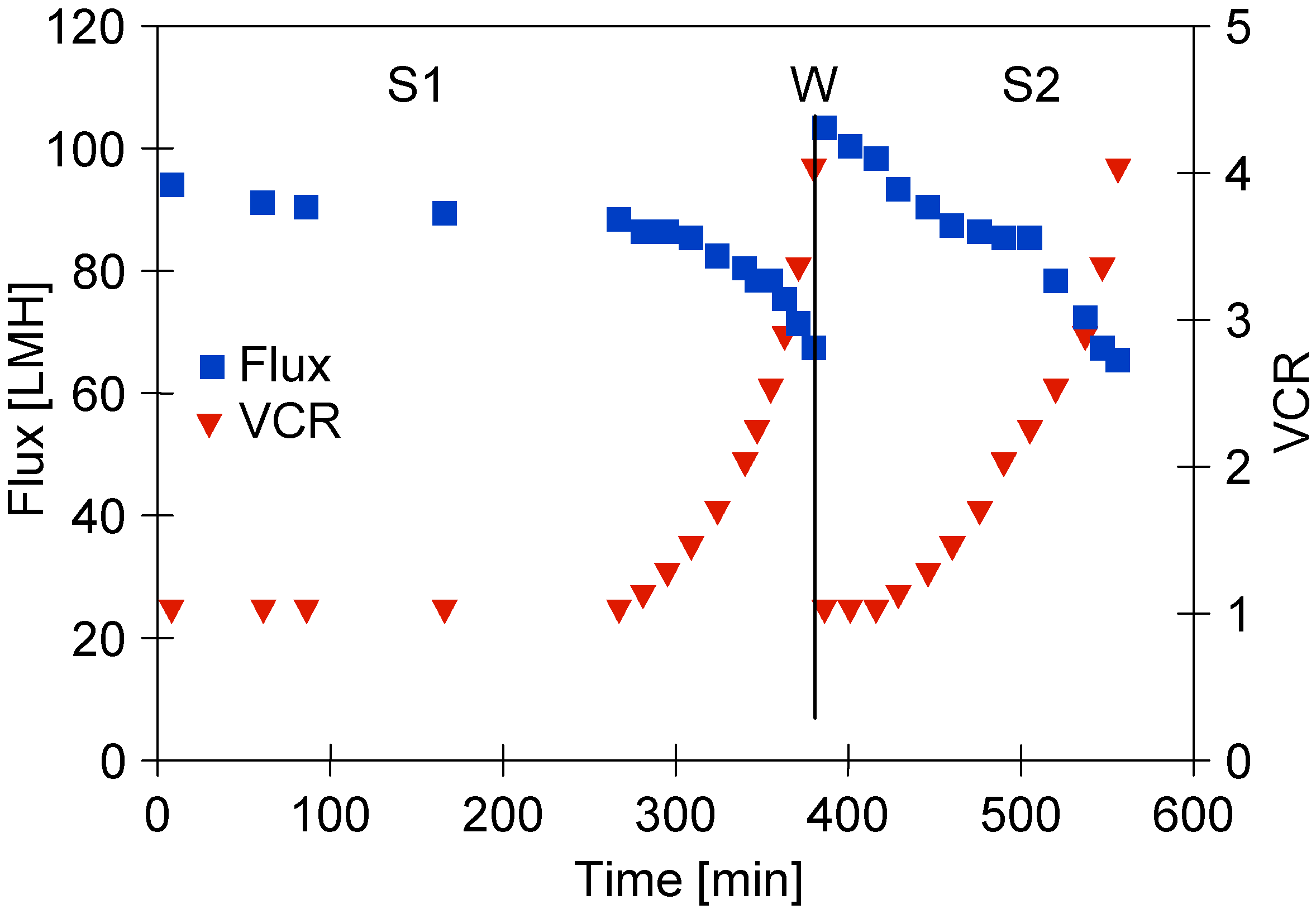
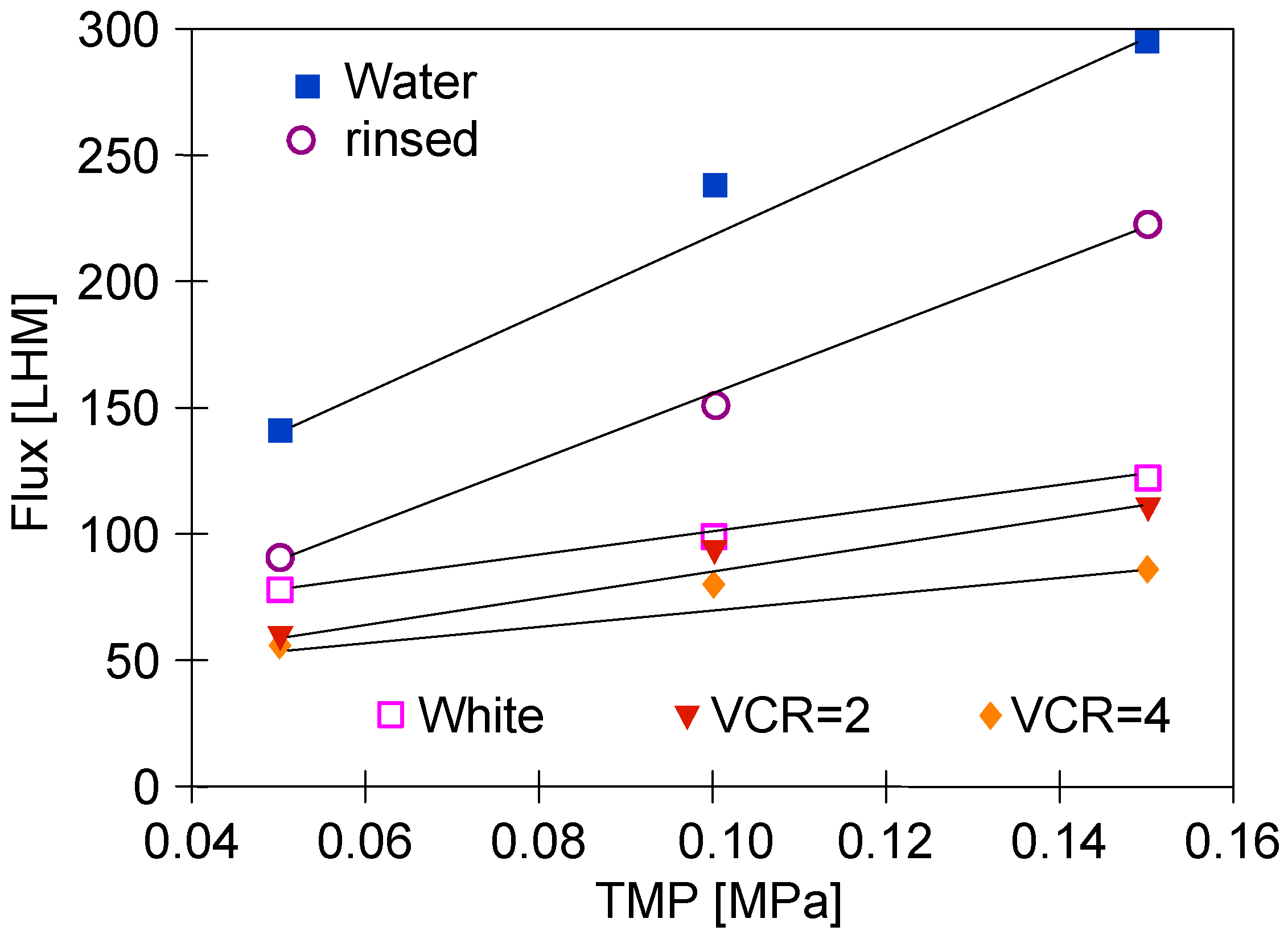
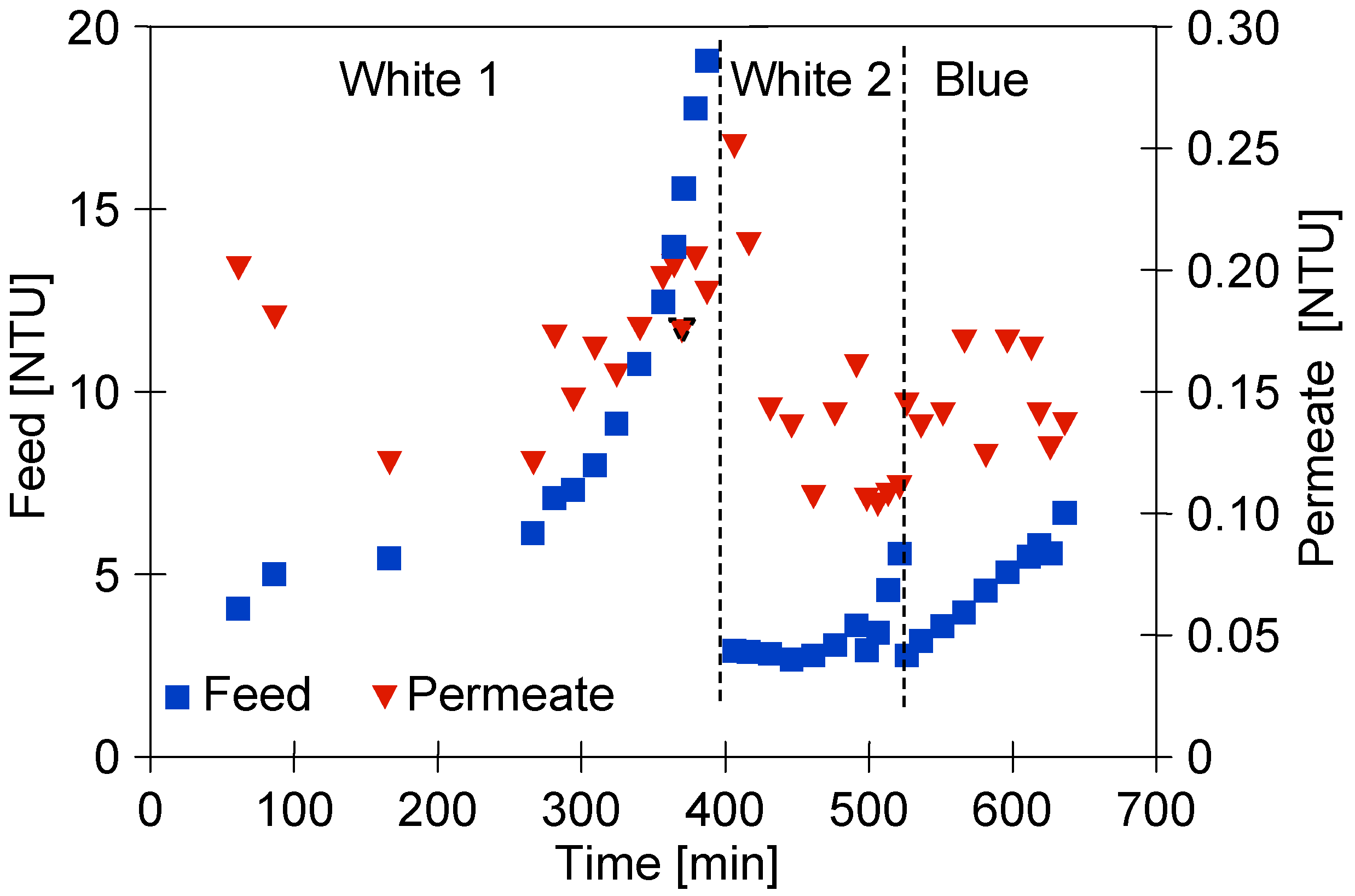

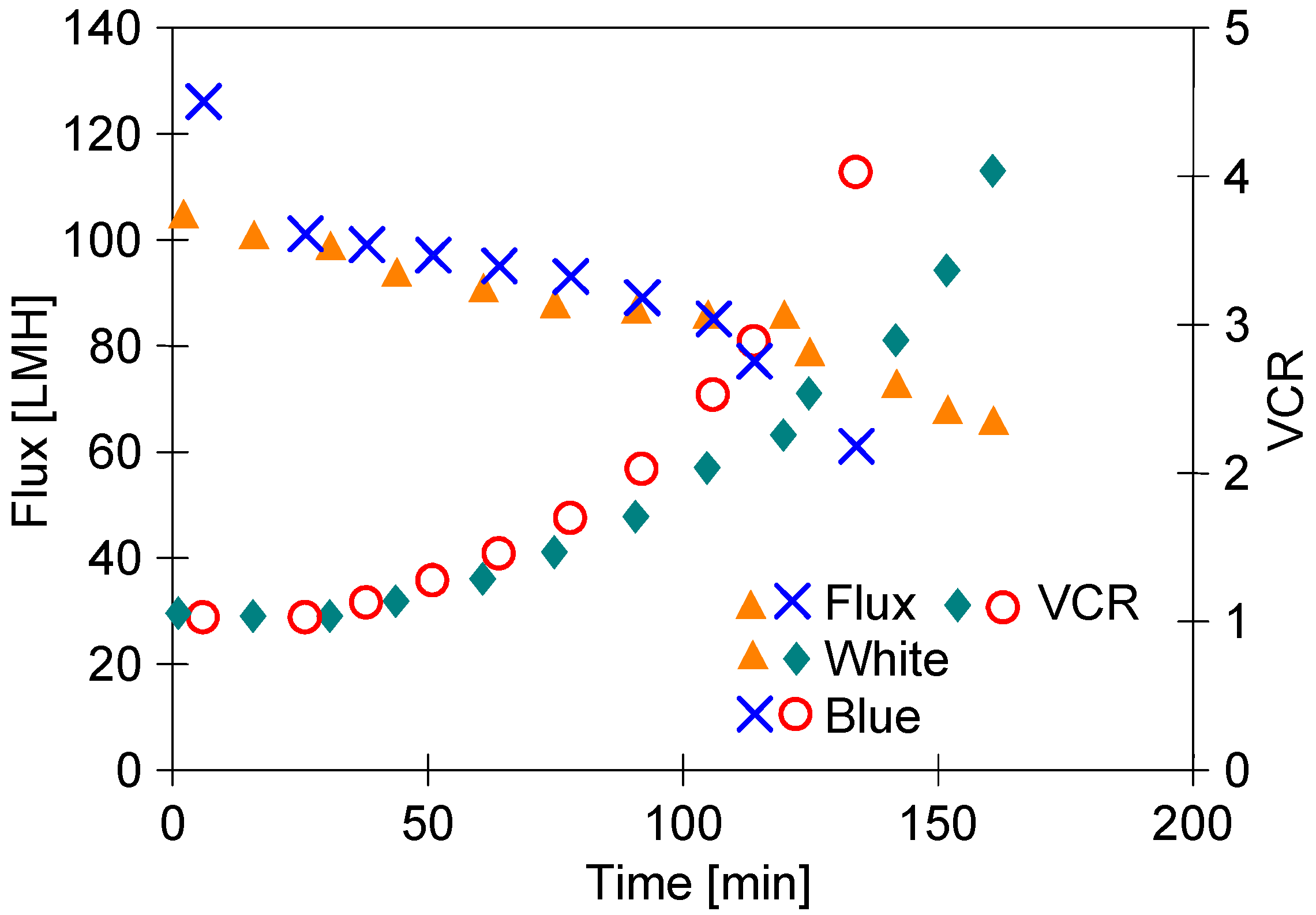
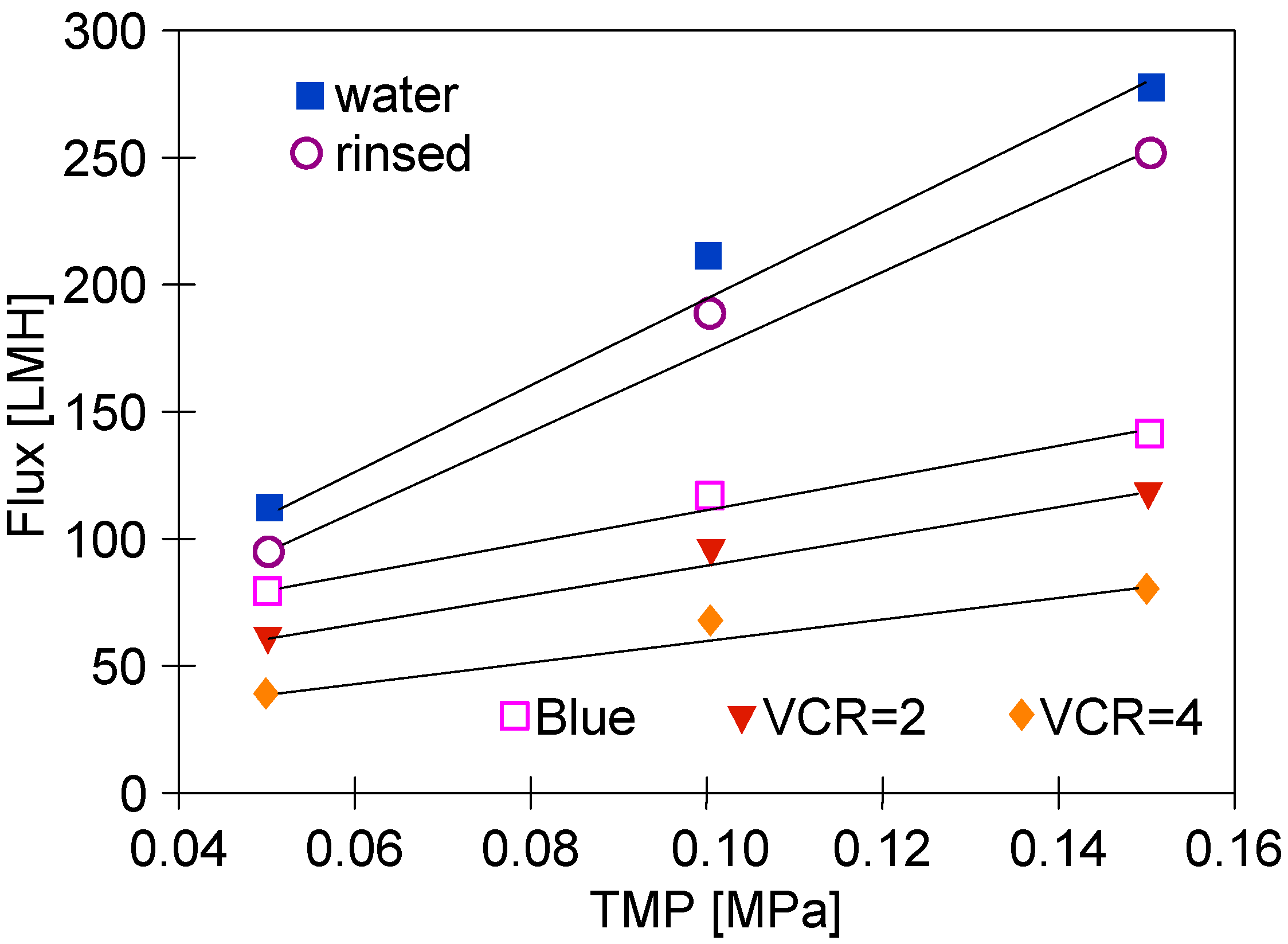
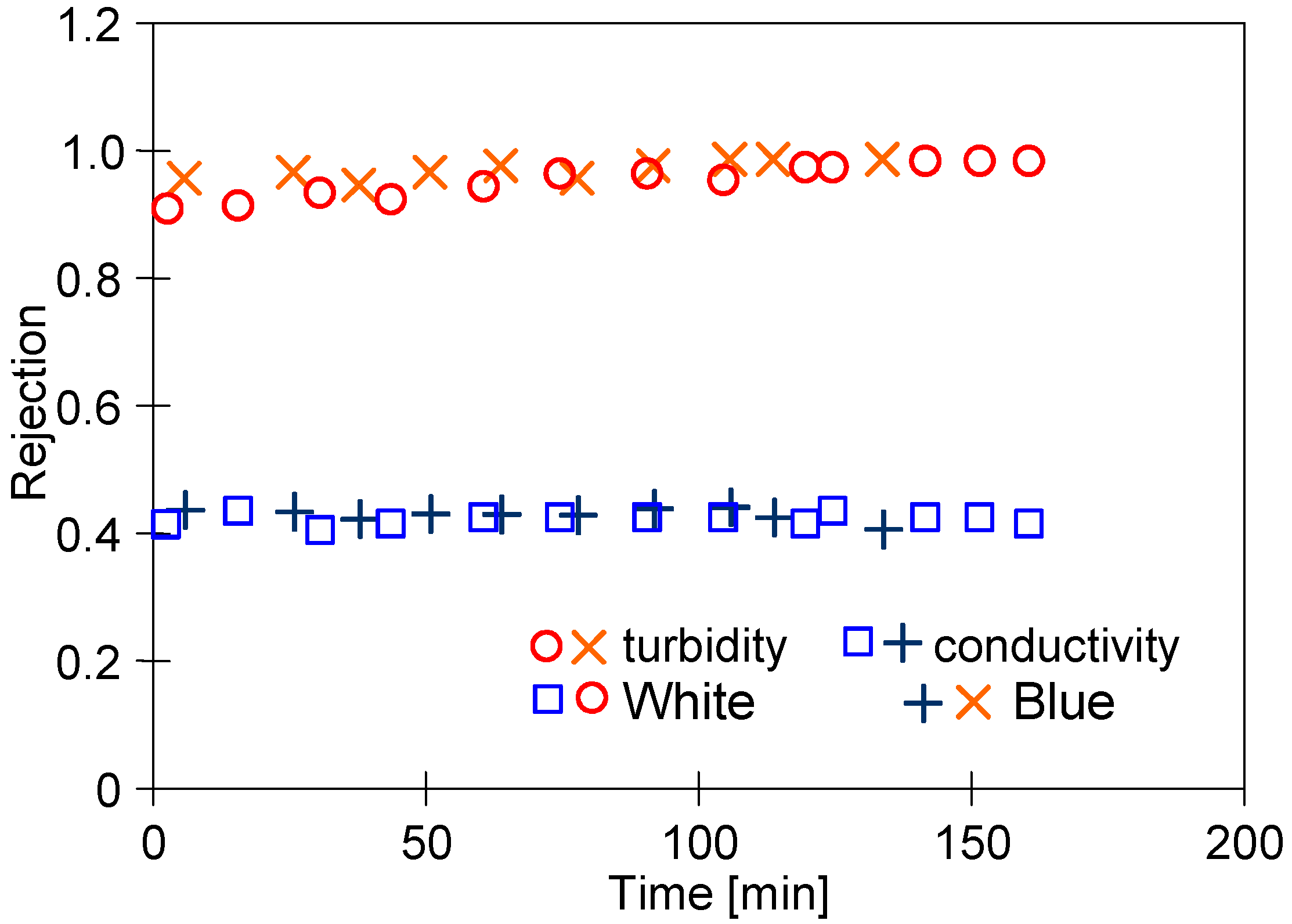

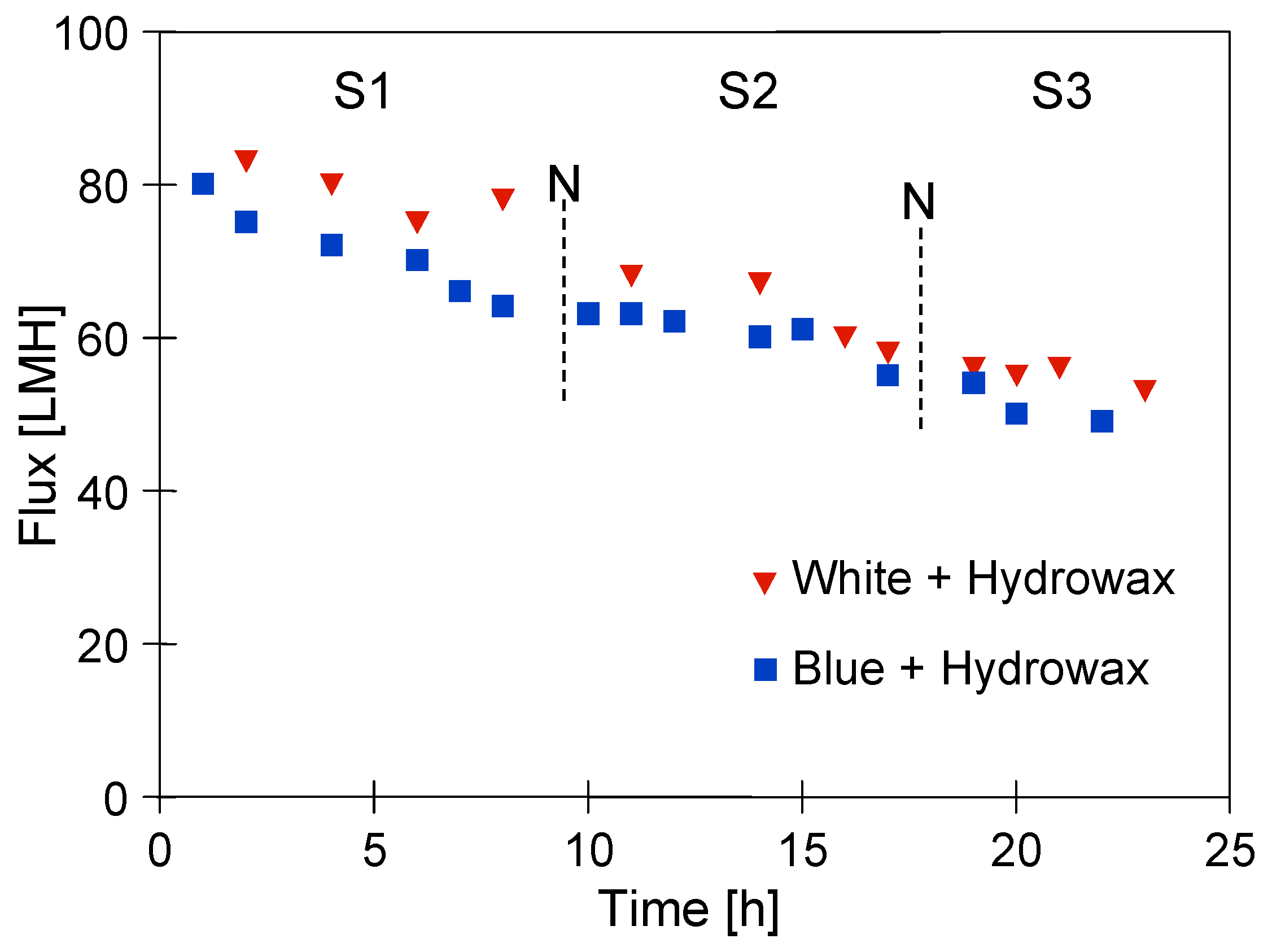

| Feed | COD [mg/L] | Anionic [mg/L] | Nonionic [mg/L] | ||||||
|---|---|---|---|---|---|---|---|---|---|
| F [%] | P [%] | R [%] | F [%] | P [%] | R [%] | F [%] | P [%] | R [%] | |
| White S1 | 2312 | 1014 | 56.2 | 776 | 269 | 65.3 | 28 | 4.0 | 85.7 |
| VCR = 2 | 3435 | 1125 | 67.2 | 916 | 270 | 70.5 | 41.8 | 4.0 | 90.4 |
| VCR = 4 | 4932 | 1195 | 75.8 | 1415 | 296 | 79.1 | 65.2 | 6.0 | 90.8 |
| White S2 | 2330 | 1030 | 55.8 | 790 | 275 | 65.2 | 27.4 | 1.20 | 95.6 |
| VCR = 2 | 3480 | 1135 | 67.4 | 940 | 277 | 70.5 | 45 | 1.55 | 96.6 |
| VCR = 4 | 5044 | 1200 | 76.2 | 1468 | 284 | 80.6 | 71 | 1.35 | 98.0 |
| Blue | 2448 | 1024 | 58.2 | 780 | 270 | 65.4 | 30 | 1.30 | 95.7 |
| VCR = 2 | 3375 | 1126 | 66.6 | 920 | 279 | 69.7 | 44.8 | 1.88 | 95.8 |
| VCR = 4 | 5028 | 1198 | 76.2 | 1438 | 288 | 80.0 | 63.6 | 2.47 | 96.1 |
| Parameter | New Membrane | Membrane Used for Separation of ‘White’ Solution | Membrane Used for Separation of ‘Blue’ Solution |
|---|---|---|---|
| Rq | 37 ± 4.9 | 43.1 ± 5.1 | 45 ± 8.1 |
| Ra | 29.7 ± 4 | 34 ± 4.8 | 35.5 ± 5.9 |
Disclaimer/Publisher’s Note: The statements, opinions and data contained in all publications are solely those of the individual author(s) and contributor(s) and not of MDPI and/or the editor(s). MDPI and/or the editor(s) disclaim responsibility for any injury to people or property resulting from any ideas, methods, instructions or products referred to in the content. |
© 2025 by the authors. Licensee MDPI, Basel, Switzerland. This article is an open access article distributed under the terms and conditions of the Creative Commons Attribution (CC BY) license (https://creativecommons.org/licenses/by/4.0/).
Share and Cite
Tomczak, W.; Woźniak, P.; Gryta, M. Ultrafiltration of Car Wash Wastewater: Pilot-Scale Studies. Water 2025, 17, 213. https://doi.org/10.3390/w17020213
Tomczak W, Woźniak P, Gryta M. Ultrafiltration of Car Wash Wastewater: Pilot-Scale Studies. Water. 2025; 17(2):213. https://doi.org/10.3390/w17020213
Chicago/Turabian StyleTomczak, Wirginia, Piotr Woźniak, and Marek Gryta. 2025. "Ultrafiltration of Car Wash Wastewater: Pilot-Scale Studies" Water 17, no. 2: 213. https://doi.org/10.3390/w17020213
APA StyleTomczak, W., Woźniak, P., & Gryta, M. (2025). Ultrafiltration of Car Wash Wastewater: Pilot-Scale Studies. Water, 17(2), 213. https://doi.org/10.3390/w17020213







